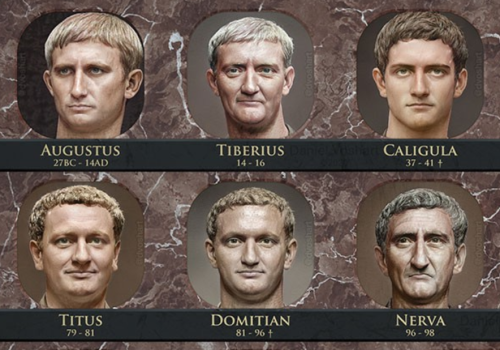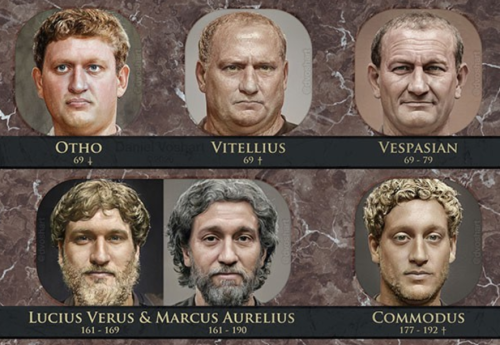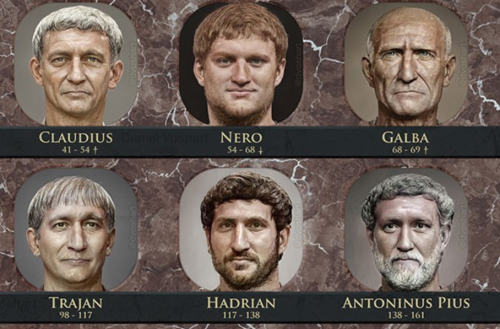awed-frog:ink-phoenix:thunderboltsortofapenny:awed-frog:a-themosthappy:cring-yuse-rname:awed-frog:Di
awed-frog:ink-phoenix:thunderboltsortofapenny:awed-frog:a-themosthappy:cring-yuse-rname:awed-frog:Digital artist Daniel Voshart recreates the ‘real’ faces of Roman emperors thanks to machine learning. You can learn more about the process, discover more emperors or buy a poster here.[Marcus Aurelius][Lucius Verus][Trajan]NO WAY IN HELL WERE THEY THIS WHITE Today we are going to discuss a very serious topic: individuals who think that Italic people were POC. I went down a rabbit hole of DNA studies trying to understand why people on tumblr seem to think the Romans were not white, and here are a few thoughts:in Europe, ‘white’ isn’t a thingin the sense that there are so many shades of white, it doesn’t really mean anythinglike, Spanish white and Swedish white are different things, but we wouldn’t consider either ‘non-white’ or ‘whiter’you can generally tell where someone’s from, but there are people who ‘look out of place’ a bit everywhereeither because recent or century-old migrations, or because of a previous population that lived there and then the borders moved or somethingand: in a nutshell, Italian geography discourages friendshipsthat means that before the Romans came along, people generally kept to themselves, so there’s more genetic diversity the farther back you goat some point in the Neolithic, there were non Indo-European tribes living in Italy, but we don’t know exactly where they came fromthe Indo-European people, on the other hand, probably invaded from the Northexcept for the Etruscans, because as it turns out, Herodotus was right (AGAIN! HAHHAHAHAHAHA SUCK IT HATERS) and they actually came from somewhere in modern Turkeywhich still doesn’t mean they weren’t white, btweven today, there’s plenty of people in the Middle East who look like this:[top to bottom: a Kurdish fighter; Iranian politician Mohammad Bagher Ghalibaf; Syrian writer Samar Yazbek]so the notion of ‘race’ as it’s understood in the US doesn’t really work elsewhereif it even works in the US, that isso anyway, from what we know from literary sources, the Romans weren’t incredibly dark(btw people abroad, and especially Americans, tend to have a fixed idea of what Italians look like and act like)(but most of the Italians who emigrated to the US came from four Southern regions - Campania, Puglia, Basilicata, Calabria, and Sicilia - and because Italy basically became a united country, like, 20 years ago, it’s still a very diverse nation)(so what you think of as a ‘typical’ Italian is probably the great-grandnephew of a ‘typical’ resident of one small village in Sicily)and the ‘typical’ Roman you often see in movies, with tanned skin, dark eyes and curly black hair, probably wasn’t a ‘typical’ Roman at allthose traits are way more common in some areas of the South - where about 37% of the population has Greek DNA because ancient coloniesso while blond hair probably wasn’t really common (we can tell because it was greatly admired and sought after, and people generally like what they don’t have), neither were darker skin and black hairin fact, a lot of politicians and other VIPs are described in the texts as having light eyes (light blue, green and gray) and some had blond or red hairothers died their hair blond with pigeon poop, but that’s another storyso the bottom line is - like modern inhabitants of Italy, ancient Romans were white, but in many cases you could probably tell from where their family came from, and some were ‘whiter’ than others depending on their ancestrythat said, the European past was a lot more diverse than our instinctive perception of itthere was a lot of trade going on, slaves from conquered lands, wealthy and poor people roaming about, and units of foreign-born Roman soldiers in unlikely places, so that’s something to keep in mind.As a bonus for reading this far, here is a smiling wolf.(Also please stop saying those guys are chads, daddys and DILFs. Most of them were dangerous sociopaths who’d feed you to their pet eels if they could.)@ink-phoenix uh. Have at it? OP forgot to add these:PertinaxCaracalla: (UL) Vatican Museum; (UR) Met, NYC; (LL) The Severan Tondo; (LR) Naples National Archaeological MuseumPhilip the Arab: (L) Vatican Museum244–249 (died aged 45 — Killed in the Battle of Verona by DeciusQuintillus [Marcus Aurelius Claudius Quintillus]FlorianusCarinusNumerianTo add to the commentary above, many of the greatest men in Roman history came from provinces outside of the Italian Peninsula, but they were and have since been considered Roman (examples: the emperor Trajan was from Hispania, and Septimus Severus was born in an African province).Later in Roman history, under Caracalla (who was born in Gaul and of mixed Berber and Syrian descent, so another Roman figure not Italian-Roman) in 212 AD all free men in the entire Roman Empire was granted citizenship. That meant that any Germanics, Africans, Latins, Hispanics, Syrian, etc. were all considered Roman! Regardless of race. This is what encompassed the Roman Empire:So you can imagine the intermixing that went on at the time and how the concept or “white” the way America presents it is absolutely inconsequential for the time period we’re talking about.After the fall of the Roman Empire, Commune cities formed, autonomous republic that survived exclusively on Marine trade with Spain, Africa, and East India. Amalfi, Gaeta and Venice in the 11th century were already autonomous maritime republics. Around 1100, Genoa, Pisa and Ancona emerged as independent maritime republics too. Trade, shipbuilding and banking helped support their powerful navies in the Mediterranean in those medieval centuries. Immigration and ethnic inter-mixing was pretty common — to the point that Italians to this day look as varied and different from north to south and from city to city as it behooves the multicultural and trade-rich peninsula it always was.Thank you for the great addition, @ink-phoenix! (Just in case there’s any doubt, the reason I didn’t include them is because I had no idea this post would be so popular and literally screenshotted the first twenty emperors on the chart to save time - and also they’re the ones I know best, there were people there I’d literally never heard of - like Ulpia Severina, I had to go and Google her.) -- source link
Tumblr Blog : awed-frog.tumblr.com
#history#rome#neat reconstitutions!!!!*


